MHS8.436: New Zealand Public Health and Maori Health Strategy
VerifiedAdded on 2022/10/02
|13
|3570
|200
Essay
AI Summary
This essay provides a comprehensive analysis of the Maori Health Strategy (MHS) within the New Zealand public health system. It explores the historical context, objectives, and implementation pathways of the MHS, emphasizing its role in addressing health inequalities and improving healthcare outcomes for Maori communities. The essay highlights the influence of the Treaty of Waitangi on health policies and strategies, underscoring the government's commitment to upholding Maori rights and promoting their health and wellbeing. It examines key elements such as reducing inequalities, building on gains, and encouraging participation of Maori communities in the health sector. Furthermore, the essay discusses the New Zealand Public Health and Disability Act 2000, its impact on healthcare funding, and the responsibilities of district health boards in delivering quality healthcare services. The essay also addresses the significance of community involvement and the allocation of resources to support Maori health initiatives, aiming to provide insights into the complexities of the New Zealand public health landscape and the ongoing efforts to improve healthcare outcomes for all New Zealanders.
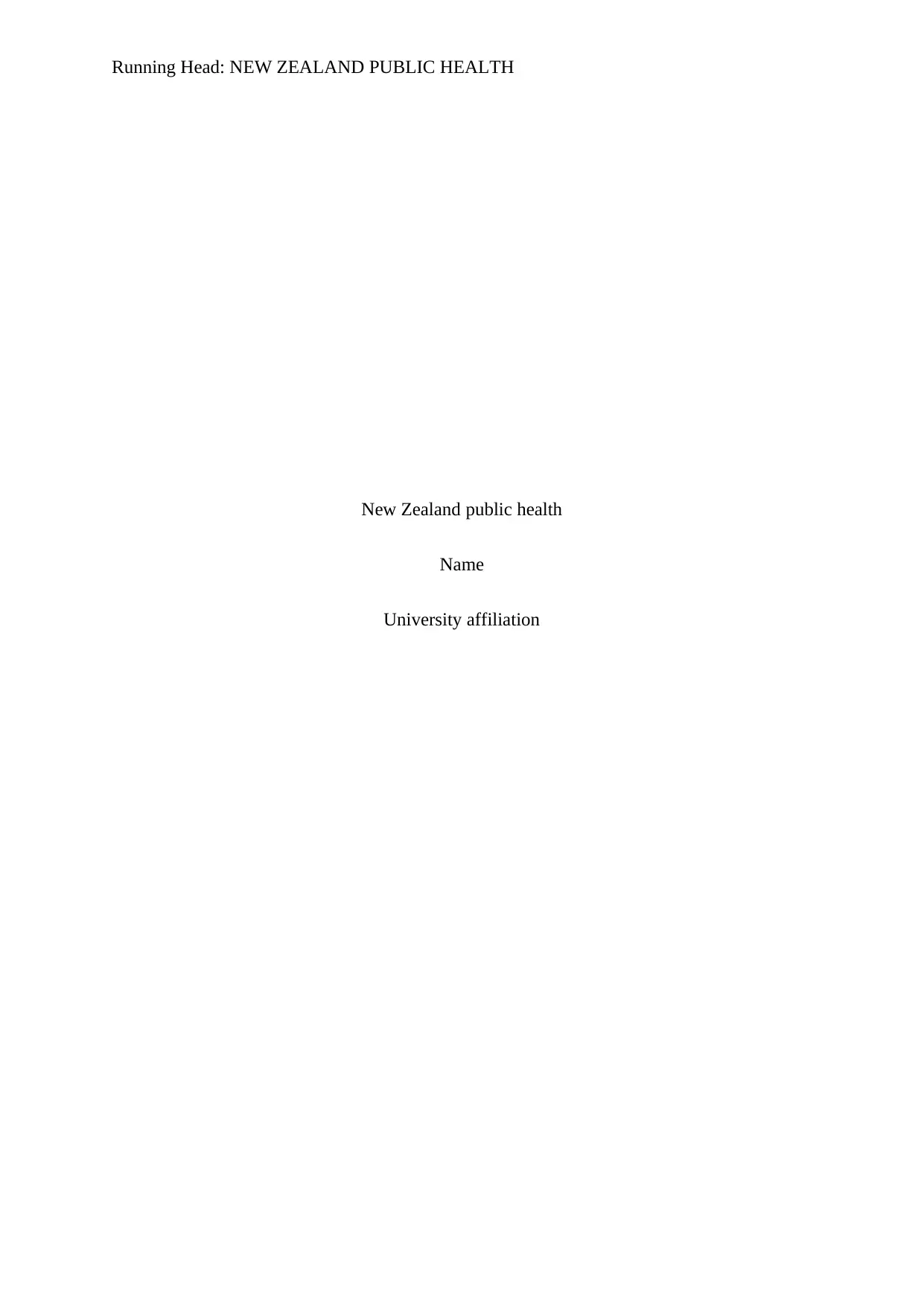
Running Head: NEW ZEALAND PUBLIC HEALTH
New Zealand public health
Name
University affiliation
New Zealand public health
Name
University affiliation
Paraphrase This Document
Need a fresh take? Get an instant paraphrase of this document with our AI Paraphraser
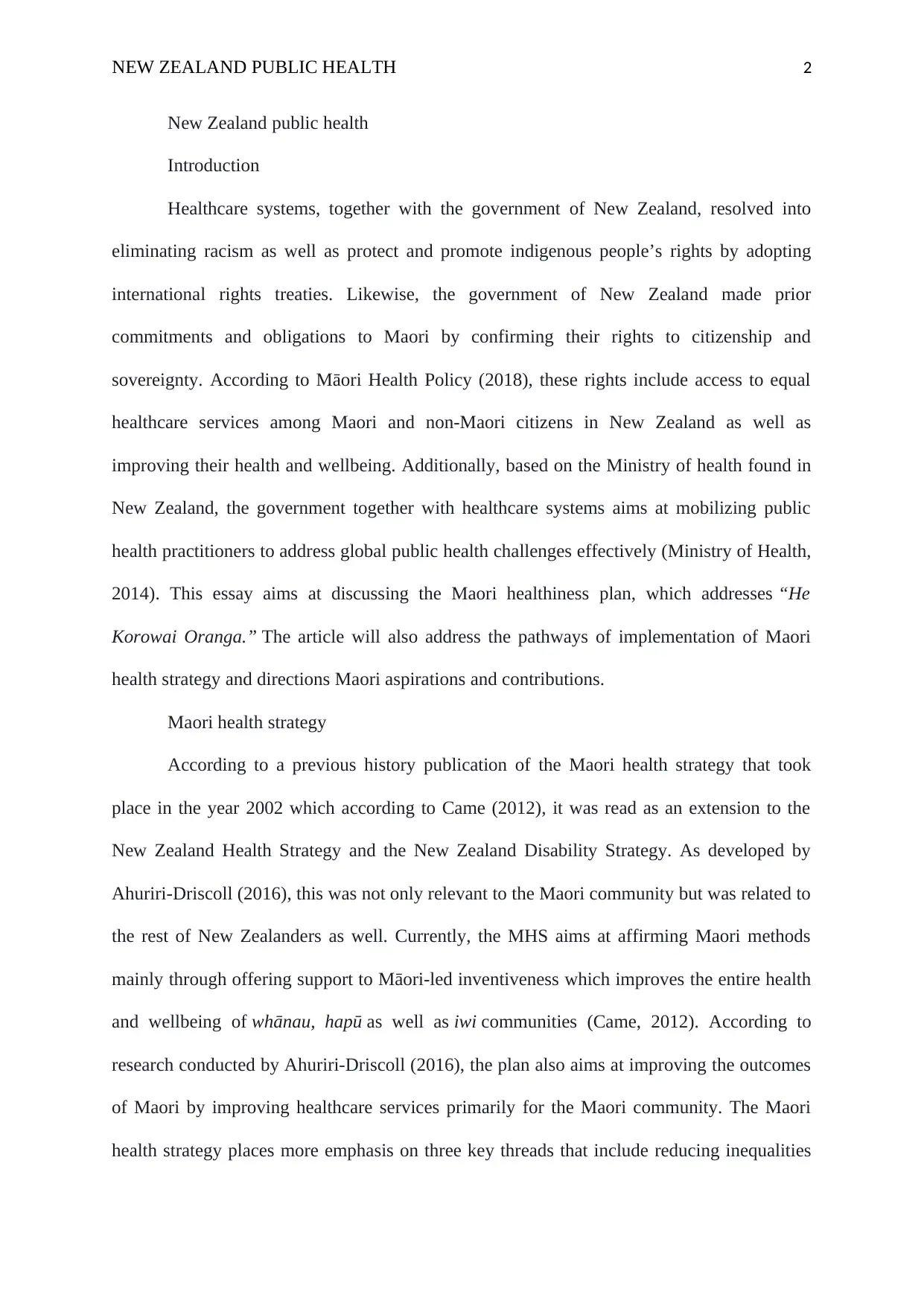
NEW ZEALAND PUBLIC HEALTH 2
New Zealand public health
Introduction
Healthcare systems, together with the government of New Zealand, resolved into
eliminating racism as well as protect and promote indigenous people’s rights by adopting
international rights treaties. Likewise, the government of New Zealand made prior
commitments and obligations to Maori by confirming their rights to citizenship and
sovereignty. According to Māori Health Policy (2018), these rights include access to equal
healthcare services among Maori and non-Maori citizens in New Zealand as well as
improving their health and wellbeing. Additionally, based on the Ministry of health found in
New Zealand, the government together with healthcare systems aims at mobilizing public
health practitioners to address global public health challenges effectively (Ministry of Health,
2014). This essay aims at discussing the Maori healthiness plan, which addresses “He
Korowai Oranga.” The article will also address the pathways of implementation of Maori
health strategy and directions Maori aspirations and contributions.
Maori health strategy
According to a previous history publication of the Maori health strategy that took
place in the year 2002 which according to Came (2012), it was read as an extension to the
New Zealand Health Strategy and the New Zealand Disability Strategy. As developed by
Ahuriri-Driscoll (2016), this was not only relevant to the Maori community but was related to
the rest of New Zealanders as well. Currently, the MHS aims at affirming Maori methods
mainly through offering support to Māori-led inventiveness which improves the entire health
and wellbeing of whānau, hapū as well as iwi communities (Came, 2012). According to
research conducted by Ahuriri-Driscoll (2016), the plan also aims at improving the outcomes
of Maori by improving healthcare services primarily for the Maori community. The Maori
health strategy places more emphasis on three key threads that include reducing inequalities
New Zealand public health
Introduction
Healthcare systems, together with the government of New Zealand, resolved into
eliminating racism as well as protect and promote indigenous people’s rights by adopting
international rights treaties. Likewise, the government of New Zealand made prior
commitments and obligations to Maori by confirming their rights to citizenship and
sovereignty. According to Māori Health Policy (2018), these rights include access to equal
healthcare services among Maori and non-Maori citizens in New Zealand as well as
improving their health and wellbeing. Additionally, based on the Ministry of health found in
New Zealand, the government together with healthcare systems aims at mobilizing public
health practitioners to address global public health challenges effectively (Ministry of Health,
2014). This essay aims at discussing the Maori healthiness plan, which addresses “He
Korowai Oranga.” The article will also address the pathways of implementation of Maori
health strategy and directions Maori aspirations and contributions.
Maori health strategy
According to a previous history publication of the Maori health strategy that took
place in the year 2002 which according to Came (2012), it was read as an extension to the
New Zealand Health Strategy and the New Zealand Disability Strategy. As developed by
Ahuriri-Driscoll (2016), this was not only relevant to the Maori community but was related to
the rest of New Zealanders as well. Currently, the MHS aims at affirming Maori methods
mainly through offering support to Māori-led inventiveness which improves the entire health
and wellbeing of whānau, hapū as well as iwi communities (Came, 2012). According to
research conducted by Ahuriri-Driscoll (2016), the plan also aims at improving the outcomes
of Maori by improving healthcare services primarily for the Maori community. The Maori
health strategy places more emphasis on three key threads that include reducing inequalities
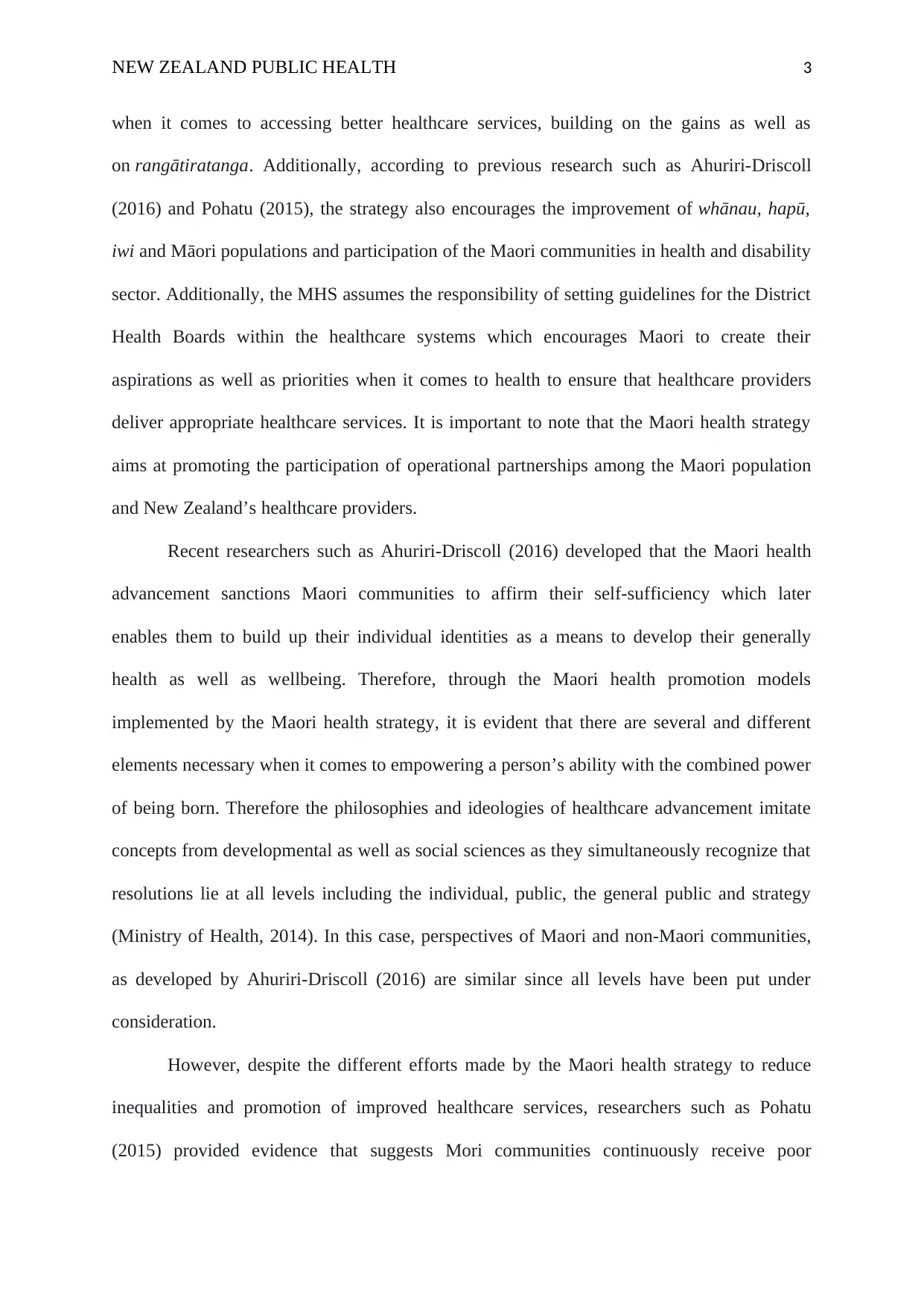
NEW ZEALAND PUBLIC HEALTH 3
when it comes to accessing better healthcare services, building on the gains as well as
on rangātiratanga. Additionally, according to previous research such as Ahuriri-Driscoll
(2016) and Pohatu (2015), the strategy also encourages the improvement of whānau, hapū,
iwi and Māori populations and participation of the Maori communities in health and disability
sector. Additionally, the MHS assumes the responsibility of setting guidelines for the District
Health Boards within the healthcare systems which encourages Maori to create their
aspirations as well as priorities when it comes to health to ensure that healthcare providers
deliver appropriate healthcare services. It is important to note that the Maori health strategy
aims at promoting the participation of operational partnerships among the Maori population
and New Zealand’s healthcare providers.
Recent researchers such as Ahuriri-Driscoll (2016) developed that the Maori health
advancement sanctions Maori communities to affirm their self-sufficiency which later
enables them to build up their individual identities as a means to develop their generally
health as well as wellbeing. Therefore, through the Maori health promotion models
implemented by the Maori health strategy, it is evident that there are several and different
elements necessary when it comes to empowering a person’s ability with the combined power
of being born. Therefore the philosophies and ideologies of healthcare advancement imitate
concepts from developmental as well as social sciences as they simultaneously recognize that
resolutions lie at all levels including the individual, public, the general public and strategy
(Ministry of Health, 2014). In this case, perspectives of Maori and non-Maori communities,
as developed by Ahuriri-Driscoll (2016) are similar since all levels have been put under
consideration.
However, despite the different efforts made by the Maori health strategy to reduce
inequalities and promotion of improved healthcare services, researchers such as Pohatu
(2015) provided evidence that suggests Mori communities continuously receive poor
when it comes to accessing better healthcare services, building on the gains as well as
on rangātiratanga. Additionally, according to previous research such as Ahuriri-Driscoll
(2016) and Pohatu (2015), the strategy also encourages the improvement of whānau, hapū,
iwi and Māori populations and participation of the Maori communities in health and disability
sector. Additionally, the MHS assumes the responsibility of setting guidelines for the District
Health Boards within the healthcare systems which encourages Maori to create their
aspirations as well as priorities when it comes to health to ensure that healthcare providers
deliver appropriate healthcare services. It is important to note that the Maori health strategy
aims at promoting the participation of operational partnerships among the Maori population
and New Zealand’s healthcare providers.
Recent researchers such as Ahuriri-Driscoll (2016) developed that the Maori health
advancement sanctions Maori communities to affirm their self-sufficiency which later
enables them to build up their individual identities as a means to develop their generally
health as well as wellbeing. Therefore, through the Maori health promotion models
implemented by the Maori health strategy, it is evident that there are several and different
elements necessary when it comes to empowering a person’s ability with the combined power
of being born. Therefore the philosophies and ideologies of healthcare advancement imitate
concepts from developmental as well as social sciences as they simultaneously recognize that
resolutions lie at all levels including the individual, public, the general public and strategy
(Ministry of Health, 2014). In this case, perspectives of Maori and non-Maori communities,
as developed by Ahuriri-Driscoll (2016) are similar since all levels have been put under
consideration.
However, despite the different efforts made by the Maori health strategy to reduce
inequalities and promotion of improved healthcare services, researchers such as Pohatu
(2015) provided evidence that suggests Mori communities continuously receive poor
⊘ This is a preview!⊘
Do you want full access?
Subscribe today to unlock all pages.

Trusted by 1+ million students worldwide
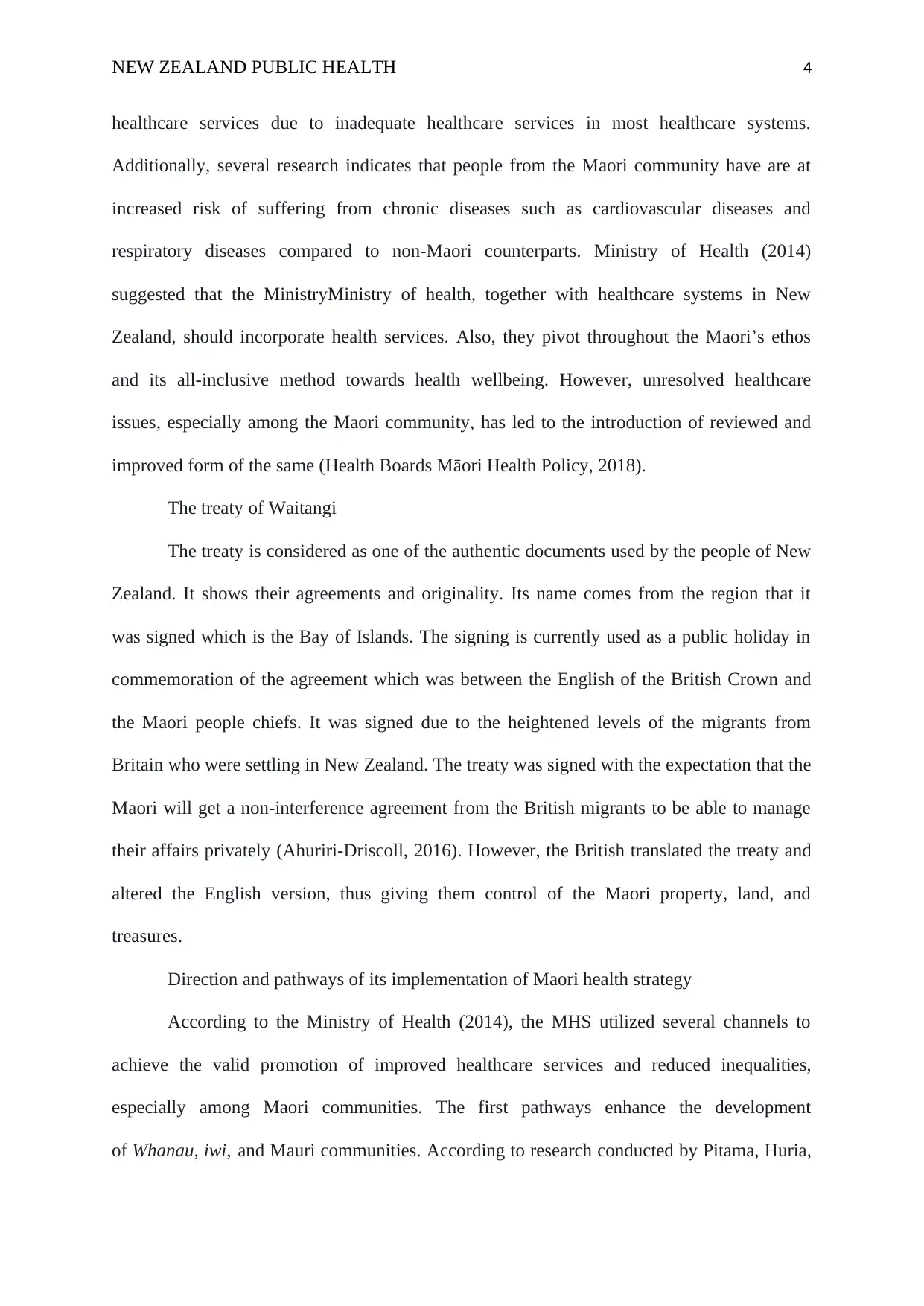
NEW ZEALAND PUBLIC HEALTH 4
healthcare services due to inadequate healthcare services in most healthcare systems.
Additionally, several research indicates that people from the Maori community have are at
increased risk of suffering from chronic diseases such as cardiovascular diseases and
respiratory diseases compared to non-Maori counterparts. Ministry of Health (2014)
suggested that the MinistryMinistry of health, together with healthcare systems in New
Zealand, should incorporate health services. Also, they pivot throughout the Maori’s ethos
and its all-inclusive method towards health wellbeing. However, unresolved healthcare
issues, especially among the Maori community, has led to the introduction of reviewed and
improved form of the same (Health Boards Māori Health Policy, 2018).
The treaty of Waitangi
The treaty is considered as one of the authentic documents used by the people of New
Zealand. It shows their agreements and originality. Its name comes from the region that it
was signed which is the Bay of Islands. The signing is currently used as a public holiday in
commemoration of the agreement which was between the English of the British Crown and
the Maori people chiefs. It was signed due to the heightened levels of the migrants from
Britain who were settling in New Zealand. The treaty was signed with the expectation that the
Maori will get a non-interference agreement from the British migrants to be able to manage
their affairs privately (Ahuriri-Driscoll, 2016). However, the British translated the treaty and
altered the English version, thus giving them control of the Maori property, land, and
treasures.
Direction and pathways of its implementation of Maori health strategy
According to the Ministry of Health (2014), the MHS utilized several channels to
achieve the valid promotion of improved healthcare services and reduced inequalities,
especially among Maori communities. The first pathways enhance the development
of Whanau, iwi, and Mauri communities. According to research conducted by Pitama, Huria,
healthcare services due to inadequate healthcare services in most healthcare systems.
Additionally, several research indicates that people from the Maori community have are at
increased risk of suffering from chronic diseases such as cardiovascular diseases and
respiratory diseases compared to non-Maori counterparts. Ministry of Health (2014)
suggested that the MinistryMinistry of health, together with healthcare systems in New
Zealand, should incorporate health services. Also, they pivot throughout the Maori’s ethos
and its all-inclusive method towards health wellbeing. However, unresolved healthcare
issues, especially among the Maori community, has led to the introduction of reviewed and
improved form of the same (Health Boards Māori Health Policy, 2018).
The treaty of Waitangi
The treaty is considered as one of the authentic documents used by the people of New
Zealand. It shows their agreements and originality. Its name comes from the region that it
was signed which is the Bay of Islands. The signing is currently used as a public holiday in
commemoration of the agreement which was between the English of the British Crown and
the Maori people chiefs. It was signed due to the heightened levels of the migrants from
Britain who were settling in New Zealand. The treaty was signed with the expectation that the
Maori will get a non-interference agreement from the British migrants to be able to manage
their affairs privately (Ahuriri-Driscoll, 2016). However, the British translated the treaty and
altered the English version, thus giving them control of the Maori property, land, and
treasures.
Direction and pathways of its implementation of Maori health strategy
According to the Ministry of Health (2014), the MHS utilized several channels to
achieve the valid promotion of improved healthcare services and reduced inequalities,
especially among Maori communities. The first pathways enhance the development
of Whanau, iwi, and Mauri communities. According to research conducted by Pitama, Huria,
Paraphrase This Document
Need a fresh take? Get an instant paraphrase of this document with our AI Paraphraser
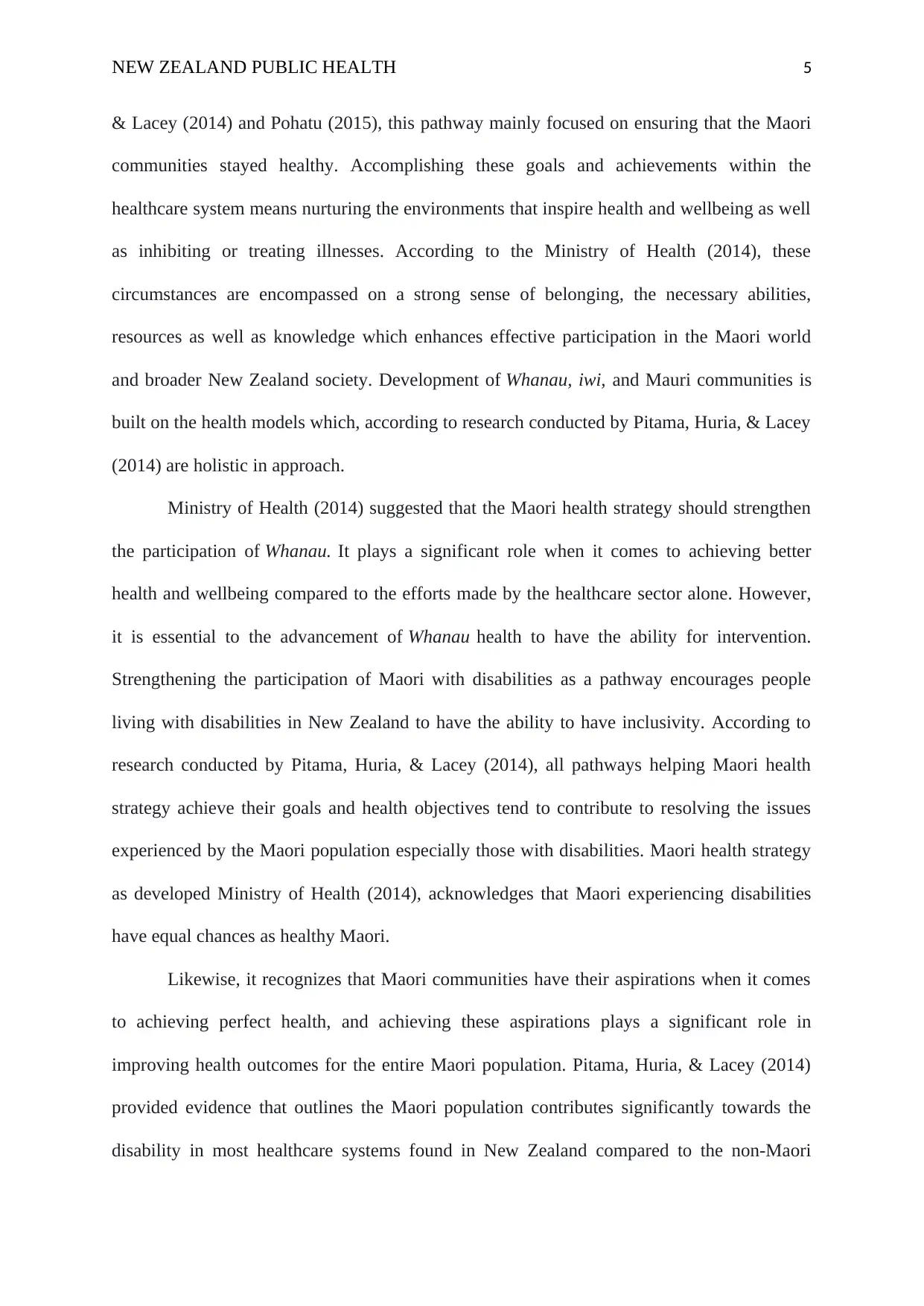
NEW ZEALAND PUBLIC HEALTH 5
& Lacey (2014) and Pohatu (2015), this pathway mainly focused on ensuring that the Maori
communities stayed healthy. Accomplishing these goals and achievements within the
healthcare system means nurturing the environments that inspire health and wellbeing as well
as inhibiting or treating illnesses. According to the Ministry of Health (2014), these
circumstances are encompassed on a strong sense of belonging, the necessary abilities,
resources as well as knowledge which enhances effective participation in the Maori world
and broader New Zealand society. Development of Whanau, iwi, and Mauri communities is
built on the health models which, according to research conducted by Pitama, Huria, & Lacey
(2014) are holistic in approach.
Ministry of Health (2014) suggested that the Maori health strategy should strengthen
the participation of Whanau. It plays a significant role when it comes to achieving better
health and wellbeing compared to the efforts made by the healthcare sector alone. However,
it is essential to the advancement of Whanau health to have the ability for intervention.
Strengthening the participation of Maori with disabilities as a pathway encourages people
living with disabilities in New Zealand to have the ability to have inclusivity. According to
research conducted by Pitama, Huria, & Lacey (2014), all pathways helping Maori health
strategy achieve their goals and health objectives tend to contribute to resolving the issues
experienced by the Maori population especially those with disabilities. Maori health strategy
as developed Ministry of Health (2014), acknowledges that Maori experiencing disabilities
have equal chances as healthy Maori.
Likewise, it recognizes that Maori communities have their aspirations when it comes
to achieving perfect health, and achieving these aspirations plays a significant role in
improving health outcomes for the entire Maori population. Pitama, Huria, & Lacey (2014)
provided evidence that outlines the Maori population contributes significantly towards the
disability in most healthcare systems found in New Zealand compared to the non-Maori
& Lacey (2014) and Pohatu (2015), this pathway mainly focused on ensuring that the Maori
communities stayed healthy. Accomplishing these goals and achievements within the
healthcare system means nurturing the environments that inspire health and wellbeing as well
as inhibiting or treating illnesses. According to the Ministry of Health (2014), these
circumstances are encompassed on a strong sense of belonging, the necessary abilities,
resources as well as knowledge which enhances effective participation in the Maori world
and broader New Zealand society. Development of Whanau, iwi, and Mauri communities is
built on the health models which, according to research conducted by Pitama, Huria, & Lacey
(2014) are holistic in approach.
Ministry of Health (2014) suggested that the Maori health strategy should strengthen
the participation of Whanau. It plays a significant role when it comes to achieving better
health and wellbeing compared to the efforts made by the healthcare sector alone. However,
it is essential to the advancement of Whanau health to have the ability for intervention.
Strengthening the participation of Maori with disabilities as a pathway encourages people
living with disabilities in New Zealand to have the ability to have inclusivity. According to
research conducted by Pitama, Huria, & Lacey (2014), all pathways helping Maori health
strategy achieve their goals and health objectives tend to contribute to resolving the issues
experienced by the Maori population especially those with disabilities. Maori health strategy
as developed Ministry of Health (2014), acknowledges that Maori experiencing disabilities
have equal chances as healthy Maori.
Likewise, it recognizes that Maori communities have their aspirations when it comes
to achieving perfect health, and achieving these aspirations plays a significant role in
improving health outcomes for the entire Maori population. Pitama, Huria, & Lacey (2014)
provided evidence that outlines the Maori population contributes significantly towards the
disability in most healthcare systems found in New Zealand compared to the non-Maori
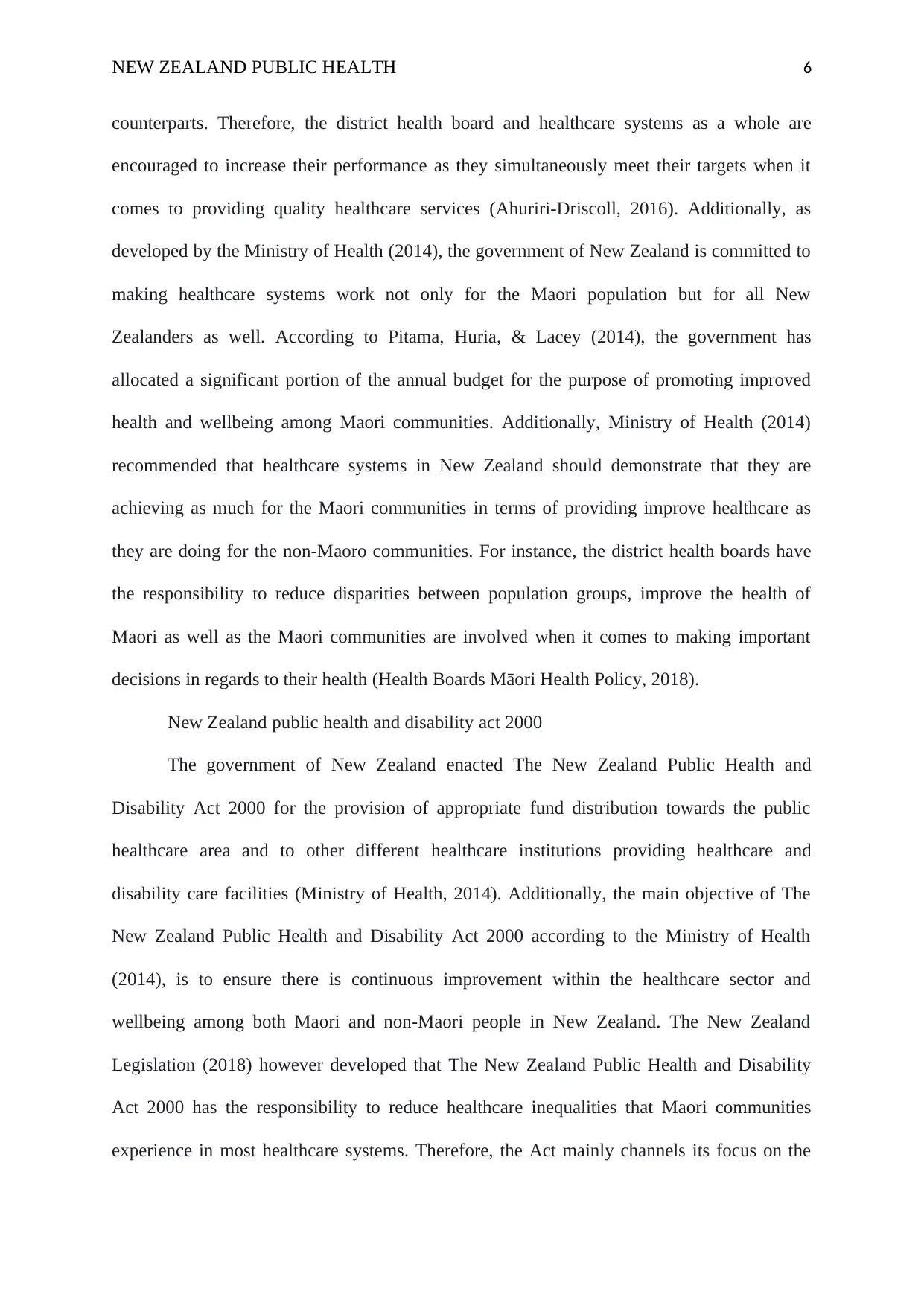
NEW ZEALAND PUBLIC HEALTH 6
counterparts. Therefore, the district health board and healthcare systems as a whole are
encouraged to increase their performance as they simultaneously meet their targets when it
comes to providing quality healthcare services (Ahuriri-Driscoll, 2016). Additionally, as
developed by the Ministry of Health (2014), the government of New Zealand is committed to
making healthcare systems work not only for the Maori population but for all New
Zealanders as well. According to Pitama, Huria, & Lacey (2014), the government has
allocated a significant portion of the annual budget for the purpose of promoting improved
health and wellbeing among Maori communities. Additionally, Ministry of Health (2014)
recommended that healthcare systems in New Zealand should demonstrate that they are
achieving as much for the Maori communities in terms of providing improve healthcare as
they are doing for the non-Maoro communities. For instance, the district health boards have
the responsibility to reduce disparities between population groups, improve the health of
Maori as well as the Maori communities are involved when it comes to making important
decisions in regards to their health (Health Boards Māori Health Policy, 2018).
New Zealand public health and disability act 2000
The government of New Zealand enacted The New Zealand Public Health and
Disability Act 2000 for the provision of appropriate fund distribution towards the public
healthcare area and to other different healthcare institutions providing healthcare and
disability care facilities (Ministry of Health, 2014). Additionally, the main objective of The
New Zealand Public Health and Disability Act 2000 according to the Ministry of Health
(2014), is to ensure there is continuous improvement within the healthcare sector and
wellbeing among both Maori and non-Maori people in New Zealand. The New Zealand
Legislation (2018) however developed that The New Zealand Public Health and Disability
Act 2000 has the responsibility to reduce healthcare inequalities that Maori communities
experience in most healthcare systems. Therefore, the Act mainly channels its focus on the
counterparts. Therefore, the district health board and healthcare systems as a whole are
encouraged to increase their performance as they simultaneously meet their targets when it
comes to providing quality healthcare services (Ahuriri-Driscoll, 2016). Additionally, as
developed by the Ministry of Health (2014), the government of New Zealand is committed to
making healthcare systems work not only for the Maori population but for all New
Zealanders as well. According to Pitama, Huria, & Lacey (2014), the government has
allocated a significant portion of the annual budget for the purpose of promoting improved
health and wellbeing among Maori communities. Additionally, Ministry of Health (2014)
recommended that healthcare systems in New Zealand should demonstrate that they are
achieving as much for the Maori communities in terms of providing improve healthcare as
they are doing for the non-Maoro communities. For instance, the district health boards have
the responsibility to reduce disparities between population groups, improve the health of
Maori as well as the Maori communities are involved when it comes to making important
decisions in regards to their health (Health Boards Māori Health Policy, 2018).
New Zealand public health and disability act 2000
The government of New Zealand enacted The New Zealand Public Health and
Disability Act 2000 for the provision of appropriate fund distribution towards the public
healthcare area and to other different healthcare institutions providing healthcare and
disability care facilities (Ministry of Health, 2014). Additionally, the main objective of The
New Zealand Public Health and Disability Act 2000 according to the Ministry of Health
(2014), is to ensure there is continuous improvement within the healthcare sector and
wellbeing among both Maori and non-Maori people in New Zealand. The New Zealand
Legislation (2018) however developed that The New Zealand Public Health and Disability
Act 2000 has the responsibility to reduce healthcare inequalities that Maori communities
experience in most healthcare systems. Therefore, the Act mainly channels its focus on the
⊘ This is a preview!⊘
Do you want full access?
Subscribe today to unlock all pages.

Trusted by 1+ million students worldwide
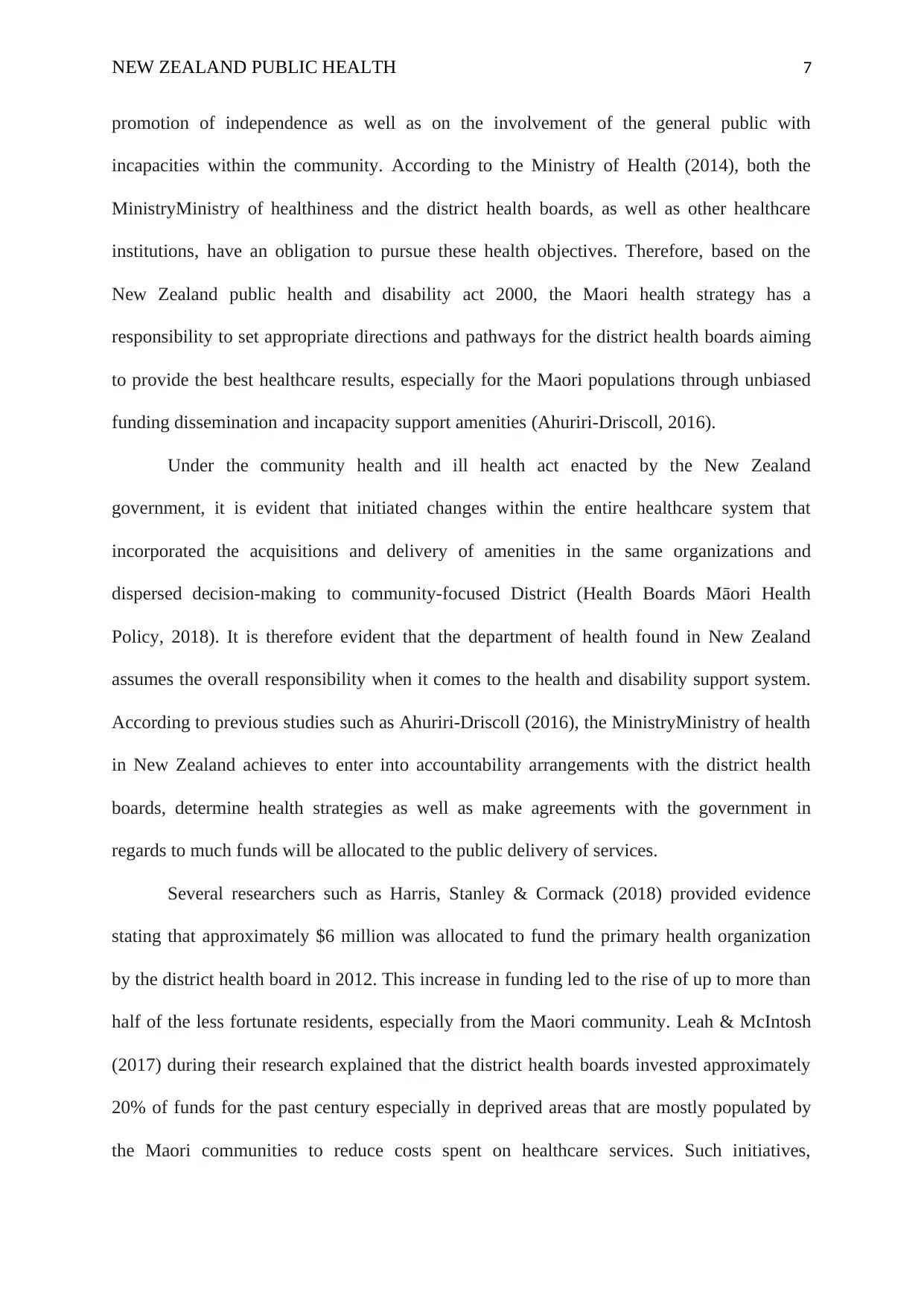
NEW ZEALAND PUBLIC HEALTH 7
promotion of independence as well as on the involvement of the general public with
incapacities within the community. According to the Ministry of Health (2014), both the
MinistryMinistry of healthiness and the district health boards, as well as other healthcare
institutions, have an obligation to pursue these health objectives. Therefore, based on the
New Zealand public health and disability act 2000, the Maori health strategy has a
responsibility to set appropriate directions and pathways for the district health boards aiming
to provide the best healthcare results, especially for the Maori populations through unbiased
funding dissemination and incapacity support amenities (Ahuriri-Driscoll, 2016).
Under the community health and ill health act enacted by the New Zealand
government, it is evident that initiated changes within the entire healthcare system that
incorporated the acquisitions and delivery of amenities in the same organizations and
dispersed decision-making to community-focused District (Health Boards Māori Health
Policy, 2018). It is therefore evident that the department of health found in New Zealand
assumes the overall responsibility when it comes to the health and disability support system.
According to previous studies such as Ahuriri-Driscoll (2016), the MinistryMinistry of health
in New Zealand achieves to enter into accountability arrangements with the district health
boards, determine health strategies as well as make agreements with the government in
regards to much funds will be allocated to the public delivery of services.
Several researchers such as Harris, Stanley & Cormack (2018) provided evidence
stating that approximately $6 million was allocated to fund the primary health organization
by the district health board in 2012. This increase in funding led to the rise of up to more than
half of the less fortunate residents, especially from the Maori community. Leah & McIntosh
(2017) during their research explained that the district health boards invested approximately
20% of funds for the past century especially in deprived areas that are mostly populated by
the Maori communities to reduce costs spent on healthcare services. Such initiatives,
promotion of independence as well as on the involvement of the general public with
incapacities within the community. According to the Ministry of Health (2014), both the
MinistryMinistry of healthiness and the district health boards, as well as other healthcare
institutions, have an obligation to pursue these health objectives. Therefore, based on the
New Zealand public health and disability act 2000, the Maori health strategy has a
responsibility to set appropriate directions and pathways for the district health boards aiming
to provide the best healthcare results, especially for the Maori populations through unbiased
funding dissemination and incapacity support amenities (Ahuriri-Driscoll, 2016).
Under the community health and ill health act enacted by the New Zealand
government, it is evident that initiated changes within the entire healthcare system that
incorporated the acquisitions and delivery of amenities in the same organizations and
dispersed decision-making to community-focused District (Health Boards Māori Health
Policy, 2018). It is therefore evident that the department of health found in New Zealand
assumes the overall responsibility when it comes to the health and disability support system.
According to previous studies such as Ahuriri-Driscoll (2016), the MinistryMinistry of health
in New Zealand achieves to enter into accountability arrangements with the district health
boards, determine health strategies as well as make agreements with the government in
regards to much funds will be allocated to the public delivery of services.
Several researchers such as Harris, Stanley & Cormack (2018) provided evidence
stating that approximately $6 million was allocated to fund the primary health organization
by the district health board in 2012. This increase in funding led to the rise of up to more than
half of the less fortunate residents, especially from the Maori community. Leah & McIntosh
(2017) during their research explained that the district health boards invested approximately
20% of funds for the past century especially in deprived areas that are mostly populated by
the Maori communities to reduce costs spent on healthcare services. Such initiatives,
Paraphrase This Document
Need a fresh take? Get an instant paraphrase of this document with our AI Paraphraser
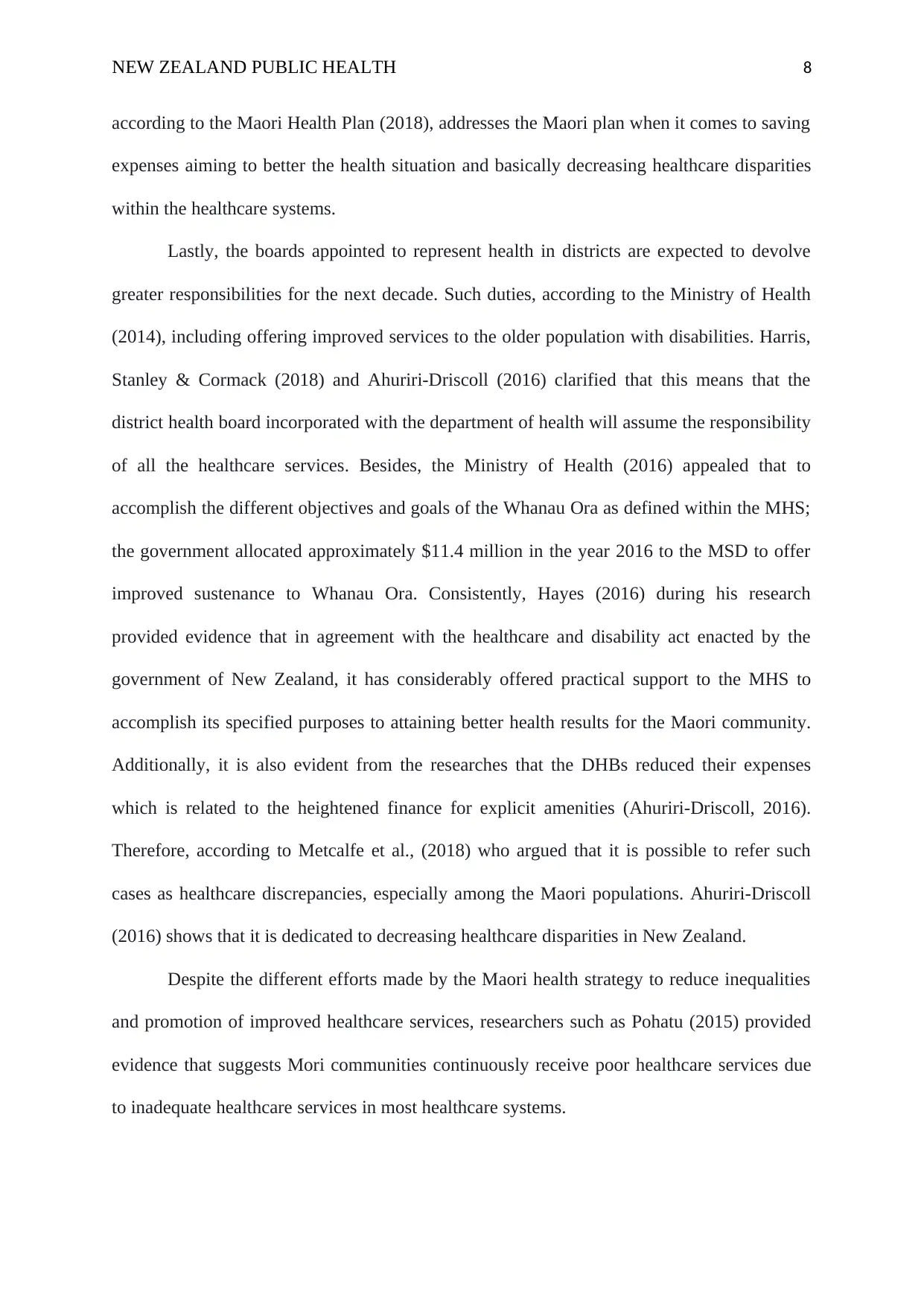
NEW ZEALAND PUBLIC HEALTH 8
according to the Maori Health Plan (2018), addresses the Maori plan when it comes to saving
expenses aiming to better the health situation and basically decreasing healthcare disparities
within the healthcare systems.
Lastly, the boards appointed to represent health in districts are expected to devolve
greater responsibilities for the next decade. Such duties, according to the Ministry of Health
(2014), including offering improved services to the older population with disabilities. Harris,
Stanley & Cormack (2018) and Ahuriri-Driscoll (2016) clarified that this means that the
district health board incorporated with the department of health will assume the responsibility
of all the healthcare services. Besides, the Ministry of Health (2016) appealed that to
accomplish the different objectives and goals of the Whanau Ora as defined within the MHS;
the government allocated approximately $11.4 million in the year 2016 to the MSD to offer
improved sustenance to Whanau Ora. Consistently, Hayes (2016) during his research
provided evidence that in agreement with the healthcare and disability act enacted by the
government of New Zealand, it has considerably offered practical support to the MHS to
accomplish its specified purposes to attaining better health results for the Maori community.
Additionally, it is also evident from the researches that the DHBs reduced their expenses
which is related to the heightened finance for explicit amenities (Ahuriri-Driscoll, 2016).
Therefore, according to Metcalfe et al., (2018) who argued that it is possible to refer such
cases as healthcare discrepancies, especially among the Maori populations. Ahuriri-Driscoll
(2016) shows that it is dedicated to decreasing healthcare disparities in New Zealand.
Despite the different efforts made by the Maori health strategy to reduce inequalities
and promotion of improved healthcare services, researchers such as Pohatu (2015) provided
evidence that suggests Mori communities continuously receive poor healthcare services due
to inadequate healthcare services in most healthcare systems.
according to the Maori Health Plan (2018), addresses the Maori plan when it comes to saving
expenses aiming to better the health situation and basically decreasing healthcare disparities
within the healthcare systems.
Lastly, the boards appointed to represent health in districts are expected to devolve
greater responsibilities for the next decade. Such duties, according to the Ministry of Health
(2014), including offering improved services to the older population with disabilities. Harris,
Stanley & Cormack (2018) and Ahuriri-Driscoll (2016) clarified that this means that the
district health board incorporated with the department of health will assume the responsibility
of all the healthcare services. Besides, the Ministry of Health (2016) appealed that to
accomplish the different objectives and goals of the Whanau Ora as defined within the MHS;
the government allocated approximately $11.4 million in the year 2016 to the MSD to offer
improved sustenance to Whanau Ora. Consistently, Hayes (2016) during his research
provided evidence that in agreement with the healthcare and disability act enacted by the
government of New Zealand, it has considerably offered practical support to the MHS to
accomplish its specified purposes to attaining better health results for the Maori community.
Additionally, it is also evident from the researches that the DHBs reduced their expenses
which is related to the heightened finance for explicit amenities (Ahuriri-Driscoll, 2016).
Therefore, according to Metcalfe et al., (2018) who argued that it is possible to refer such
cases as healthcare discrepancies, especially among the Maori populations. Ahuriri-Driscoll
(2016) shows that it is dedicated to decreasing healthcare disparities in New Zealand.
Despite the different efforts made by the Maori health strategy to reduce inequalities
and promotion of improved healthcare services, researchers such as Pohatu (2015) provided
evidence that suggests Mori communities continuously receive poor healthcare services due
to inadequate healthcare services in most healthcare systems.
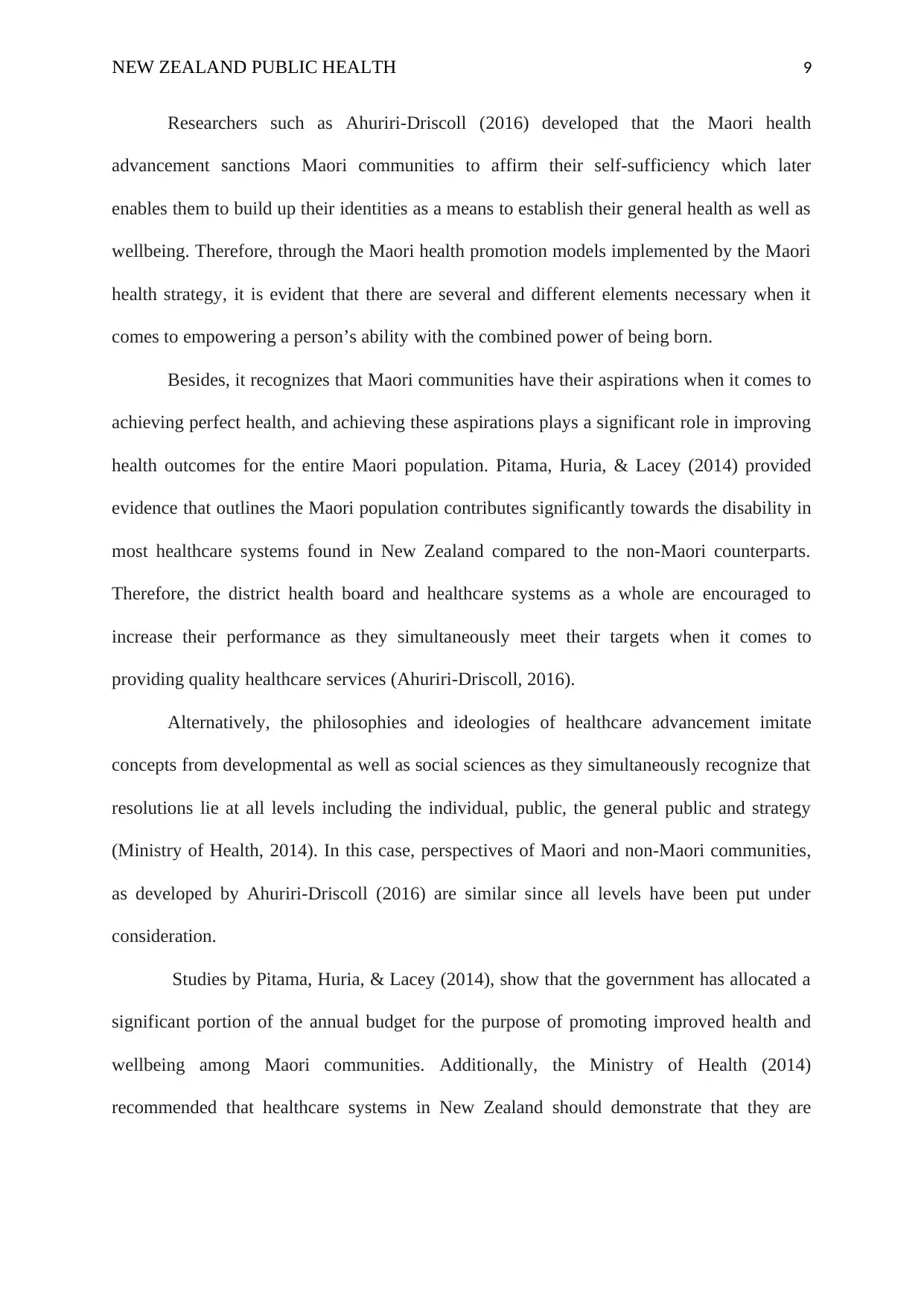
NEW ZEALAND PUBLIC HEALTH 9
Researchers such as Ahuriri-Driscoll (2016) developed that the Maori health
advancement sanctions Maori communities to affirm their self-sufficiency which later
enables them to build up their identities as a means to establish their general health as well as
wellbeing. Therefore, through the Maori health promotion models implemented by the Maori
health strategy, it is evident that there are several and different elements necessary when it
comes to empowering a person’s ability with the combined power of being born.
Besides, it recognizes that Maori communities have their aspirations when it comes to
achieving perfect health, and achieving these aspirations plays a significant role in improving
health outcomes for the entire Maori population. Pitama, Huria, & Lacey (2014) provided
evidence that outlines the Maori population contributes significantly towards the disability in
most healthcare systems found in New Zealand compared to the non-Maori counterparts.
Therefore, the district health board and healthcare systems as a whole are encouraged to
increase their performance as they simultaneously meet their targets when it comes to
providing quality healthcare services (Ahuriri-Driscoll, 2016).
Alternatively, the philosophies and ideologies of healthcare advancement imitate
concepts from developmental as well as social sciences as they simultaneously recognize that
resolutions lie at all levels including the individual, public, the general public and strategy
(Ministry of Health, 2014). In this case, perspectives of Maori and non-Maori communities,
as developed by Ahuriri-Driscoll (2016) are similar since all levels have been put under
consideration.
Studies by Pitama, Huria, & Lacey (2014), show that the government has allocated a
significant portion of the annual budget for the purpose of promoting improved health and
wellbeing among Maori communities. Additionally, the Ministry of Health (2014)
recommended that healthcare systems in New Zealand should demonstrate that they are
Researchers such as Ahuriri-Driscoll (2016) developed that the Maori health
advancement sanctions Maori communities to affirm their self-sufficiency which later
enables them to build up their identities as a means to establish their general health as well as
wellbeing. Therefore, through the Maori health promotion models implemented by the Maori
health strategy, it is evident that there are several and different elements necessary when it
comes to empowering a person’s ability with the combined power of being born.
Besides, it recognizes that Maori communities have their aspirations when it comes to
achieving perfect health, and achieving these aspirations plays a significant role in improving
health outcomes for the entire Maori population. Pitama, Huria, & Lacey (2014) provided
evidence that outlines the Maori population contributes significantly towards the disability in
most healthcare systems found in New Zealand compared to the non-Maori counterparts.
Therefore, the district health board and healthcare systems as a whole are encouraged to
increase their performance as they simultaneously meet their targets when it comes to
providing quality healthcare services (Ahuriri-Driscoll, 2016).
Alternatively, the philosophies and ideologies of healthcare advancement imitate
concepts from developmental as well as social sciences as they simultaneously recognize that
resolutions lie at all levels including the individual, public, the general public and strategy
(Ministry of Health, 2014). In this case, perspectives of Maori and non-Maori communities,
as developed by Ahuriri-Driscoll (2016) are similar since all levels have been put under
consideration.
Studies by Pitama, Huria, & Lacey (2014), show that the government has allocated a
significant portion of the annual budget for the purpose of promoting improved health and
wellbeing among Maori communities. Additionally, the Ministry of Health (2014)
recommended that healthcare systems in New Zealand should demonstrate that they are
⊘ This is a preview!⊘
Do you want full access?
Subscribe today to unlock all pages.

Trusted by 1+ million students worldwide
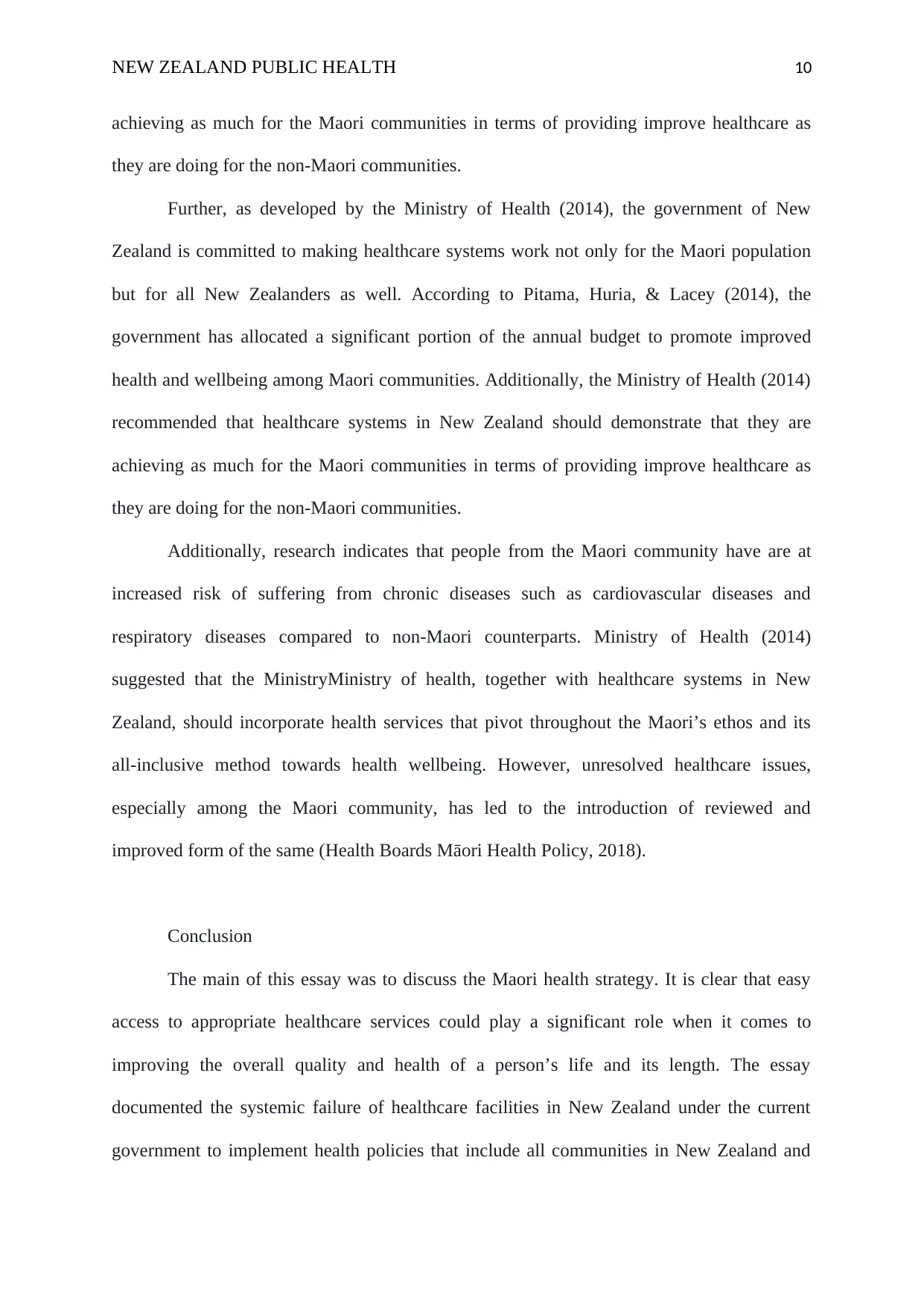
NEW ZEALAND PUBLIC HEALTH 10
achieving as much for the Maori communities in terms of providing improve healthcare as
they are doing for the non-Maori communities.
Further, as developed by the Ministry of Health (2014), the government of New
Zealand is committed to making healthcare systems work not only for the Maori population
but for all New Zealanders as well. According to Pitama, Huria, & Lacey (2014), the
government has allocated a significant portion of the annual budget to promote improved
health and wellbeing among Maori communities. Additionally, the Ministry of Health (2014)
recommended that healthcare systems in New Zealand should demonstrate that they are
achieving as much for the Maori communities in terms of providing improve healthcare as
they are doing for the non-Maori communities.
Additionally, research indicates that people from the Maori community have are at
increased risk of suffering from chronic diseases such as cardiovascular diseases and
respiratory diseases compared to non-Maori counterparts. Ministry of Health (2014)
suggested that the MinistryMinistry of health, together with healthcare systems in New
Zealand, should incorporate health services that pivot throughout the Maori’s ethos and its
all-inclusive method towards health wellbeing. However, unresolved healthcare issues,
especially among the Maori community, has led to the introduction of reviewed and
improved form of the same (Health Boards Māori Health Policy, 2018).
Conclusion
The main of this essay was to discuss the Maori health strategy. It is clear that easy
access to appropriate healthcare services could play a significant role when it comes to
improving the overall quality and health of a person’s life and its length. The essay
documented the systemic failure of healthcare facilities in New Zealand under the current
government to implement health policies that include all communities in New Zealand and
achieving as much for the Maori communities in terms of providing improve healthcare as
they are doing for the non-Maori communities.
Further, as developed by the Ministry of Health (2014), the government of New
Zealand is committed to making healthcare systems work not only for the Maori population
but for all New Zealanders as well. According to Pitama, Huria, & Lacey (2014), the
government has allocated a significant portion of the annual budget to promote improved
health and wellbeing among Maori communities. Additionally, the Ministry of Health (2014)
recommended that healthcare systems in New Zealand should demonstrate that they are
achieving as much for the Maori communities in terms of providing improve healthcare as
they are doing for the non-Maori communities.
Additionally, research indicates that people from the Maori community have are at
increased risk of suffering from chronic diseases such as cardiovascular diseases and
respiratory diseases compared to non-Maori counterparts. Ministry of Health (2014)
suggested that the MinistryMinistry of health, together with healthcare systems in New
Zealand, should incorporate health services that pivot throughout the Maori’s ethos and its
all-inclusive method towards health wellbeing. However, unresolved healthcare issues,
especially among the Maori community, has led to the introduction of reviewed and
improved form of the same (Health Boards Māori Health Policy, 2018).
Conclusion
The main of this essay was to discuss the Maori health strategy. It is clear that easy
access to appropriate healthcare services could play a significant role when it comes to
improving the overall quality and health of a person’s life and its length. The essay
documented the systemic failure of healthcare facilities in New Zealand under the current
government to implement health policies that include all communities in New Zealand and
Paraphrase This Document
Need a fresh take? Get an instant paraphrase of this document with our AI Paraphraser
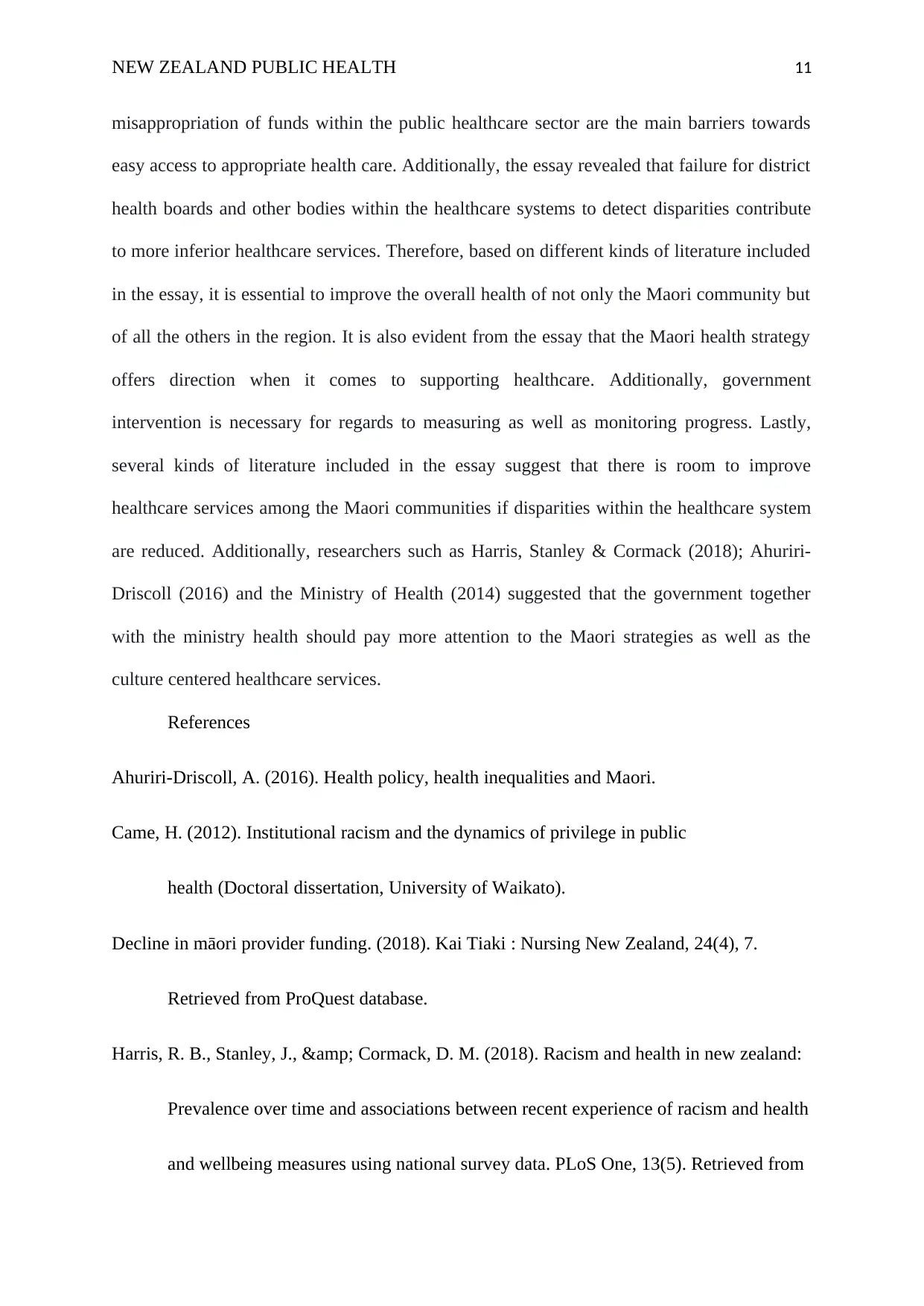
NEW ZEALAND PUBLIC HEALTH 11
misappropriation of funds within the public healthcare sector are the main barriers towards
easy access to appropriate health care. Additionally, the essay revealed that failure for district
health boards and other bodies within the healthcare systems to detect disparities contribute
to more inferior healthcare services. Therefore, based on different kinds of literature included
in the essay, it is essential to improve the overall health of not only the Maori community but
of all the others in the region. It is also evident from the essay that the Maori health strategy
offers direction when it comes to supporting healthcare. Additionally, government
intervention is necessary for regards to measuring as well as monitoring progress. Lastly,
several kinds of literature included in the essay suggest that there is room to improve
healthcare services among the Maori communities if disparities within the healthcare system
are reduced. Additionally, researchers such as Harris, Stanley & Cormack (2018); Ahuriri-
Driscoll (2016) and the Ministry of Health (2014) suggested that the government together
with the ministry health should pay more attention to the Maori strategies as well as the
culture centered healthcare services.
References
Ahuriri-Driscoll, A. (2016). Health policy, health inequalities and Maori.
Came, H. (2012). Institutional racism and the dynamics of privilege in public
health (Doctoral dissertation, University of Waikato).
Decline in māori provider funding. (2018). Kai Tiaki : Nursing New Zealand, 24(4), 7.
Retrieved from ProQuest database.
Harris, R. B., Stanley, J., & Cormack, D. M. (2018). Racism and health in new zealand:
Prevalence over time and associations between recent experience of racism and health
and wellbeing measures using national survey data. PLoS One, 13(5). Retrieved from
misappropriation of funds within the public healthcare sector are the main barriers towards
easy access to appropriate health care. Additionally, the essay revealed that failure for district
health boards and other bodies within the healthcare systems to detect disparities contribute
to more inferior healthcare services. Therefore, based on different kinds of literature included
in the essay, it is essential to improve the overall health of not only the Maori community but
of all the others in the region. It is also evident from the essay that the Maori health strategy
offers direction when it comes to supporting healthcare. Additionally, government
intervention is necessary for regards to measuring as well as monitoring progress. Lastly,
several kinds of literature included in the essay suggest that there is room to improve
healthcare services among the Maori communities if disparities within the healthcare system
are reduced. Additionally, researchers such as Harris, Stanley & Cormack (2018); Ahuriri-
Driscoll (2016) and the Ministry of Health (2014) suggested that the government together
with the ministry health should pay more attention to the Maori strategies as well as the
culture centered healthcare services.
References
Ahuriri-Driscoll, A. (2016). Health policy, health inequalities and Maori.
Came, H. (2012). Institutional racism and the dynamics of privilege in public
health (Doctoral dissertation, University of Waikato).
Decline in māori provider funding. (2018). Kai Tiaki : Nursing New Zealand, 24(4), 7.
Retrieved from ProQuest database.
Harris, R. B., Stanley, J., & Cormack, D. M. (2018). Racism and health in new zealand:
Prevalence over time and associations between recent experience of racism and health
and wellbeing measures using national survey data. PLoS One, 13(5). Retrieved from
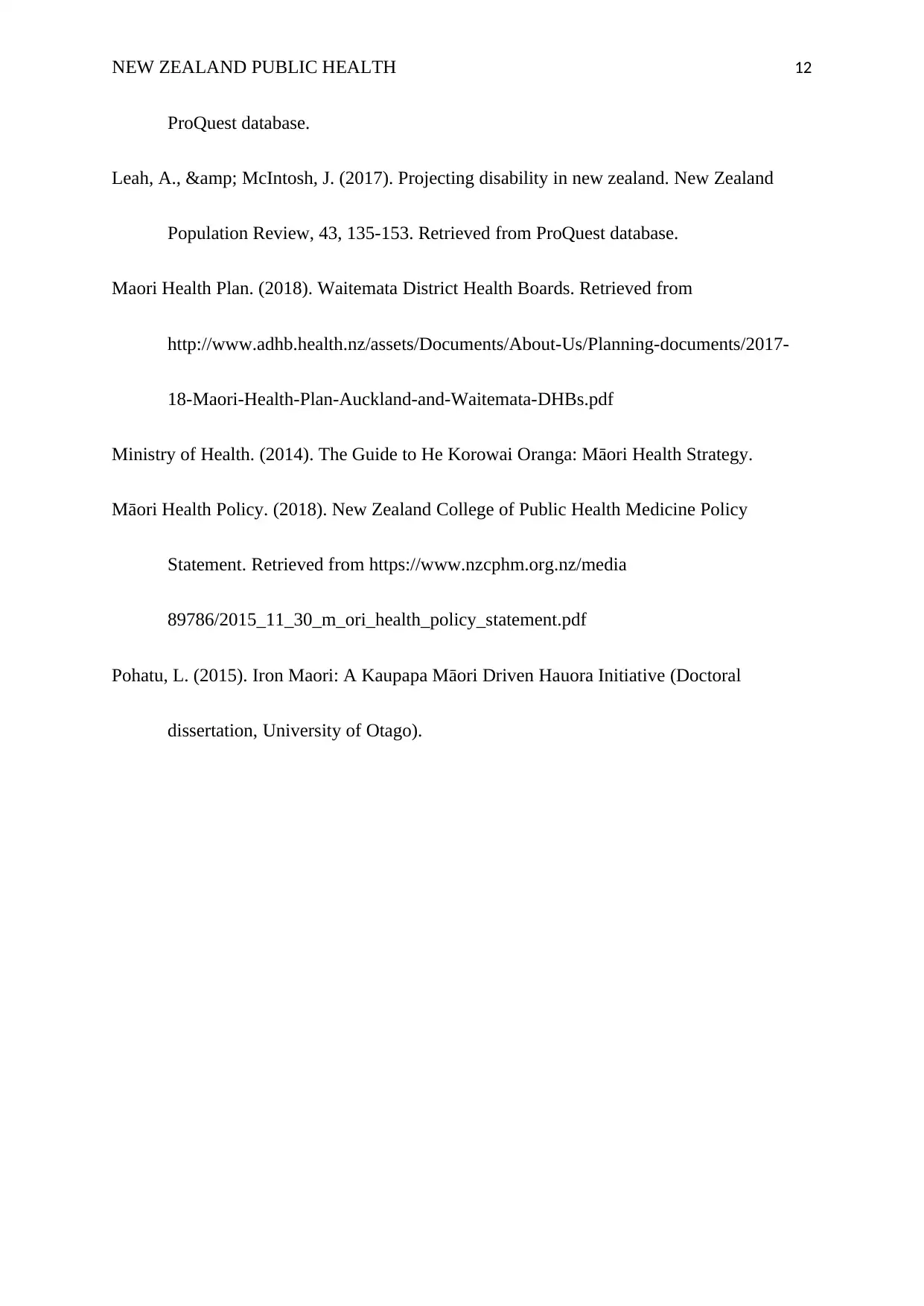
NEW ZEALAND PUBLIC HEALTH 12
ProQuest database.
Leah, A., & McIntosh, J. (2017). Projecting disability in new zealand. New Zealand
Population Review, 43, 135-153. Retrieved from ProQuest database.
Maori Health Plan. (2018). Waitemata District Health Boards. Retrieved from
http://www.adhb.health.nz/assets/Documents/About-Us/Planning-documents/2017-
18-Maori-Health-Plan-Auckland-and-Waitemata-DHBs.pdf
Ministry of Health. (2014). The Guide to He Korowai Oranga: Māori Health Strategy.
Māori Health Policy. (2018). New Zealand College of Public Health Medicine Policy
Statement. Retrieved from https://www.nzcphm.org.nz/media
89786/2015_11_30_m_ori_health_policy_statement.pdf
Pohatu, L. (2015). Iron Maori: A Kaupapa Māori Driven Hauora Initiative (Doctoral
dissertation, University of Otago).
ProQuest database.
Leah, A., & McIntosh, J. (2017). Projecting disability in new zealand. New Zealand
Population Review, 43, 135-153. Retrieved from ProQuest database.
Maori Health Plan. (2018). Waitemata District Health Boards. Retrieved from
http://www.adhb.health.nz/assets/Documents/About-Us/Planning-documents/2017-
18-Maori-Health-Plan-Auckland-and-Waitemata-DHBs.pdf
Ministry of Health. (2014). The Guide to He Korowai Oranga: Māori Health Strategy.
Māori Health Policy. (2018). New Zealand College of Public Health Medicine Policy
Statement. Retrieved from https://www.nzcphm.org.nz/media
89786/2015_11_30_m_ori_health_policy_statement.pdf
Pohatu, L. (2015). Iron Maori: A Kaupapa Māori Driven Hauora Initiative (Doctoral
dissertation, University of Otago).
⊘ This is a preview!⊘
Do you want full access?
Subscribe today to unlock all pages.

Trusted by 1+ million students worldwide
1 out of 13
Related Documents
Your All-in-One AI-Powered Toolkit for Academic Success.
+13062052269
info@desklib.com
Available 24*7 on WhatsApp / Email
![[object Object]](/_next/static/media/star-bottom.7253800d.svg)
Unlock your academic potential
Copyright © 2020–2025 A2Z Services. All Rights Reserved. Developed and managed by ZUCOL.





